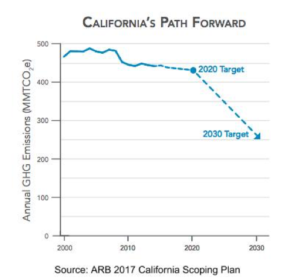The momentum for decarbonization by local jurisdictions seems to be growing stronger by the day. Recently, the City of Los Angeles passed a resolution to develop strategies for fuel substitution and set targets for electrification that their climate goals. This is a huge step forward for such a large city but large or small it is clear that local jurisdictions will once again lead the way to more sustainable and healthy communities for all.
Building Decarbonization

According to data gathered by NRDC, 41% of residential and commercial buildings are emitting carbon emissions due to onsite fossil fuel burning from space/water heating and cooking so there is more that can be done to decarbonize our buildings to meet the ambitious emissions reductions targets outlined in ARB’s 2017 California Scoping Plan.
One strategy to decarbonize our buildings is to update our old appliances with newer more efficient electric options such as heat pump water heaters and induction cooktops. But space/water heating and cooking have been dominated by natural gas in California for many years and those habits can be hard to break.
Efficient electric appliances improve our comfort, save energy, and reduce carbon emissions but we need to bring awareness to our communities. Cities like Berkeley set up a webpage for residents and installers highlighting the economic and environmental benefits, providing resources for installation and permitting, and links to utility rebates.
On the state policy side of things local jurisdictions can support advocacy efforts already underway to increase broader electrification of buildings in California. NRDC, the Sierra Club, and the California Energy Efficiency Industry Council have led a challenge to the CPUC’s Three Pronged Fuel Substitution Test. The current form of that test limits a consumer’s ability to switch from natural gas to electric appliances through utility funded state programs. Technologies such as heat pump water heaters are dropping in cost but creating additional incentives to replace old natural gas appliances will make it easier for consumers to make the switch.
Lastly, local jurisdictions can take a more direct approach to increase electrification of buildings through local energy codes. LocalEnergyCodes.com (see Low-Rise Residential New Construction: All-Electric Design) provides free resources such as model language and cost-effectiveness studies necessary to implement all-electric codes in their communities.
The momentum for decarbonization by local jurisdictions seems to be growing stronger by the day. Recently, the City of Los Angeles passed a resolution to develop strategies for fuel substitution and set targets for electrification that their climate goals. This is a huge step forward for such a large city but large or small it is clear that local jurisdictions will once again lead the way to more sustainable and healthy communities for all.
Local Government Commission Newsletters
Livable Places Update
CURRENTS Newsletter
CivicSpark™ Newsletter
LGC Newsletters
Keep up to date with LGC’s newsletters!
Livable Places Update – April
April’s article: Microtransit: Right-Sizing Transportation to Improve Community Mobility
Currents: Spring 2019
Currents provides readers with current information on energy issues affecting local governments in California.
CivicSpark Newsletter – March
This monthly CivicSpark newsletter features updates on CivicSpark projects and highlights.




